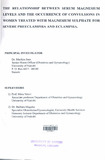| dc.contributor.author | Machira, Jane | |
| dc.date.accessioned | 2013-05-24T08:24:44Z | |
| dc.date.available | 2013-05-24T08:24:44Z | |
| dc.date.issued | 2009 | |
| dc.identifier.citation | Masters of medicine dissertion in obstetrics and Gynaecology, | en |
| dc.identifier.uri | http://erepository.uonbi.ac.ke:8080/xmlui/handle/123456789/25227 | |
| dc.description.abstract | Maternal mortality and morbidity in eclampsia is directly related to the number of convulsions
thus optimum prevention of convulsions in eclampsia and severe pre-eclampsia is vital.
Magnesium sulphate has been shown to be to be supreme in control of these convulsions but
despite this, a number of patients continue to convulse during therapy. Studies done show that the
levels of serum. magnesium achieved during treatment with magnesium su Iphate dose regimen
vary depending on the body mass index and that patients with higher body mass index do not
achieve therapeutic levels. It is thus prudent to determine the serum levels of Magnesium in
patients treated with magnesium sulphate to determine the frequency of subtherapeutic levels and
whether this contributes to the recorded failure to control convulsions seen in some of these
patients.
OBJECTIVE:
To determine if sub-therapeutic levels of serum magnesium III patients with severe
preeclampsia/eclampsia on treatment with magnesium sulphate are associated with occurrence of
convulsions.
METHODOLOGY'
This was a prospective cohort study of patients in two serum magnesium categories (therapeutic
• and subtherapeutic magnesium levels) on treatment with magnesium sulphate for severe
preeclampsia and eclampsia. A baseline survey of magnesium levels after administration of the
loading dose (4 grams over 5 to 15 minutes as per the protocol) was done at recruitment was done
and 101 patients with subtherapeutic levels and 69 with therapeutic levels were followed up to
determine the occurrence of convulsions.
RESULTS
With the magnesium sulphate regimen of 4 grams loading dose and a maintenance dose of 1 gram
hourly that was used in the study 101(59.4%) of the 170 patients with severe
preeclampsia/eclampsia had subtherapeutic levels while 69(40.6%) of them had therapeutic
levels. Of the patients who convulsed while on these standard dosing regimen, 78.1% had
subtherapeutic serum magnesium levels while 21.9% had therapeutic serum magnesium levels.
The odds for convulsions for patients with subtherapeutic serum magnesium levels was 2.91 that
for those patients with therapeutic serum magnesium levels ( 95% CI 1.10 to 7.98, P = 0.016).
The body mass index was inversely proportional to the serum magnesium levels and the two were
highly correlated (p<0.05). The odds of subtherapeutic serum magnesium levels with a high BMI
(Overweight or more) was 86.5 times that for those patients with a normal BMI ( 95% CI 13.6-
355.5, P = 0.001).
9
CONCLUSIONS
The standard dose regimen of magnesium sulphate used of 4 grams loading dose and 1 gram
hourly for maintenance failed to give therapeutic levels of serum magnesium in a majority of
patients. Many of the patients who convulsed while on treatment with magnesium levels had
subtherapeutic serum magnesium levels. A high body mass index in the patients was associated
with subtherapeutic levels.
RECOMMENDA TIONS
Studies testing drug regimens based on body mass index or higher doses should be formulated
with a goal to improve the control of convulsions in patients with eclampsia/severe eclampsia . | en |
| dc.description.sponsorship | University of Nairobi | en |
| dc.language.iso | en | en |
| dc.title | The relationship between serum magnesium levels and the occurrence of convulsions in women treated with magnesium sulphate for severe preeclampsia and eclampsia | en |
| dc.type | Thesis | en |
| dc.description.department | a
Department of Psychiatry, University of Nairobi, ; bDepartment of Mental Health, School of Medicine,
Moi University, Eldoret, Kenya | |
| local.publisher | Department of Obstetrics and Gynaecology University of Nairobi | en |

